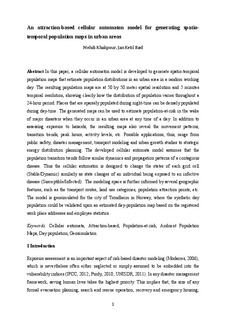An attraction-based cellular automaton model for generating spatiotemporal population maps in urban areas
Journal article, Peer reviewed
Accepted version
Permanent lenke
http://hdl.handle.net/11250/2450794Utgivelsesdato
2015Metadata
Vis full innførselSamlinger
- Institutt for geografi [1119]
- Publikasjoner fra CRIStin - NTNU [38679]
Originalversjon
Environment and Planning, B: Planning and Design. 2015, 43 (2), 297-319. 10.1177/0265813515604262Sammendrag
We develop a cellular automaton (CA) model to produce spatiotemporal population maps that estimate population distributions in an urban area during a random working day. The resulting population maps are at 50 m and 5 minutes spatiotemporal resolution, showing clearly how the distribution of population varies throughout a 24-hour period. The maps indicate that some areas of the city, which are sparsely populated during the night, can be densely populated during the day. The developed CA model assumes that the population transition trends follow dynamics and propagation patterns similar to a contagious disease. Thus, our model designed to change the states of each grid cell (stable or dynamic) in a way that is similar to changes in the condition of individuals who are exposed to an infectious disease (susceptible or infected). In addition, the modeling space is informed by several geographic features, such as the transport routes, land-use categories, and population attraction points. The model is geosimulated for the city of Trondheim in Norway, where the synthetic day population could be validated using an estimated day-population map based on the registered workplace addresses and employee statistics. The generated maps can be used to estimate a value for the population-at-risk in the wake of a major disaster that occurs in an urban area at any time of a day. In addition to assessing exposure to hazards, the resulting maps also reveal movement patterns, transition trends, peak hours, and activity levels. Possible applications range from public safety, disaster management, transport modeling, and urban growth studies to strategic energy distribution planning.
